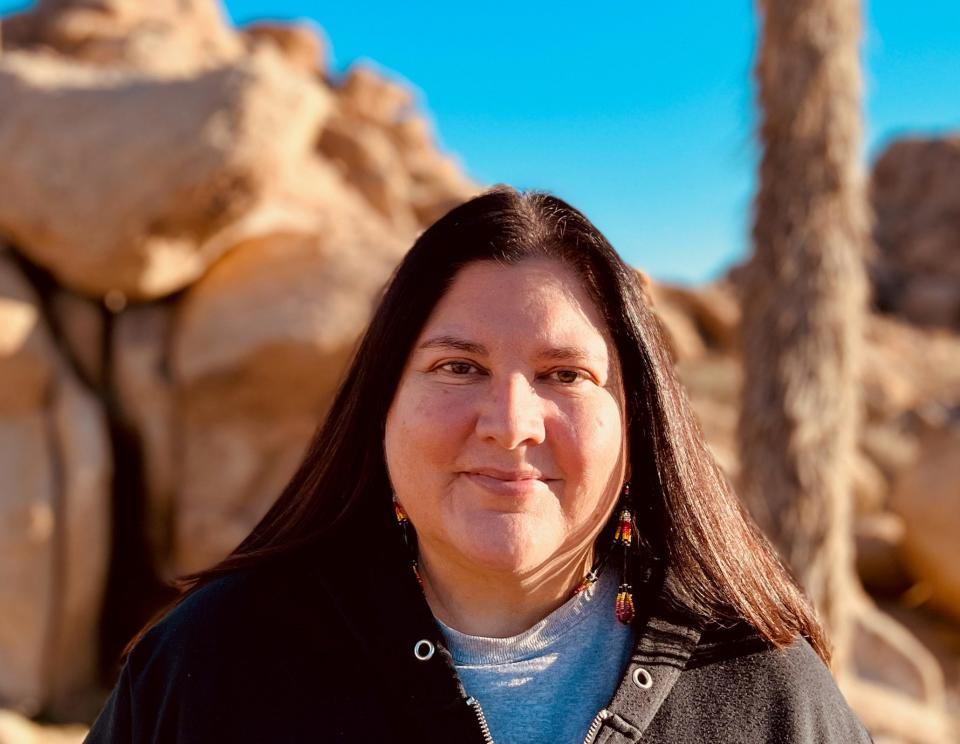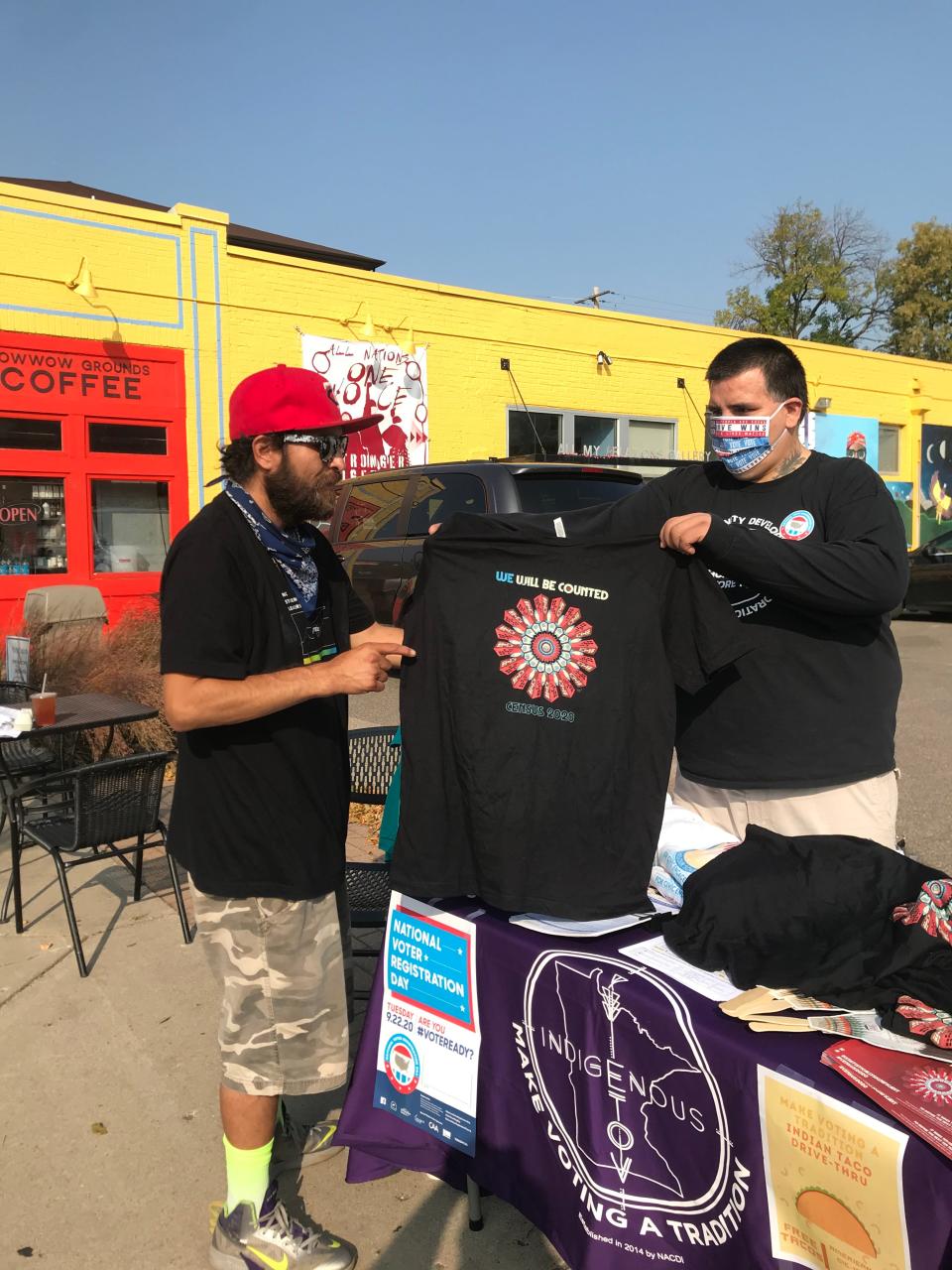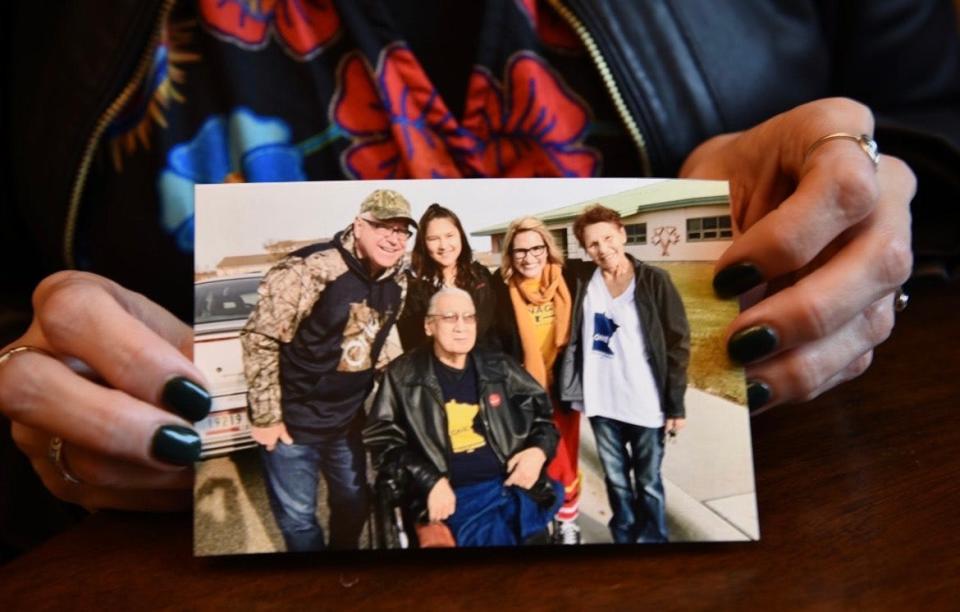100 years of redefining Indigenous enfranchisement in Minnesota
- Oops!Something went wrong.Please try again later.
Correction: An earlier version of this story incorrectly noted the number of past lieutenant governors in Minnesota history. Peggy Flanagan is the 50th lieutenant governor.
2024 marks the 100-year commemoration of the U.S. government granting citizenship to Indigenous Americans. The Indian Citizenship Act naturalized hundreds of thousands, all but giving them the right to vote.
Full enfranchisement would take decades of activism and perseverance, and the reality of casting ballots would vary from paper to practice for decades to come.
One hundred years later, a local educator, an organizer, and a politician reflect on the many steps towards suffrage.
More: Minnesota gets A plus rating for voter access
A brief history of Indigenous voting rights in Minnesota
For hundreds of years, the United States government used promises of naturalization and enfranchisement to take land from Indigenous peoples and further urge assimilation.
In 1788, the ratification of the U.S. Constitution made it clear: Indigenous people were not American citizens and would not enjoy the right to vote.
Unlike many other states, Minnesota had built into its Constitution a provision that would allow select Indigenous people to vote, given they demonstrate a willingness to submit to the government.
In 1858, Minnesota became the 32nd state. The Minnesota Constitution prohibited Indigenous men from voting unless they were able to prove, via examination, that they had "adopted the language, customs, and habits of civilization".
"Persons of Indian blood residing in this state who have adopted the language, customs and habits of civilization, after an examination before any District Court of the State, in such manner as may be provided by law, and shall have been pronounced by said Court capable of enjoying the rights of citizenship within the State."
(Minn. Const., art. VII § 1(4) (1858)
Over 65 years later, The Indian Citizenship Act was signed into law by President Calvin Coolidge on June 2, 1924.
Though the signing of the measure seemingly ended the arduous, federal, dispute over citizenship, it would not fully secure Indigenous people's right vote. The Constitution gave states broad power over executing elections, and states continued to bar their vote by implementing Jim Crow-like laws.
Iyekiyapiwin Darlene St. Clair, a citizen of the Lower Sioux Indian Community, professor, and director of the Multicultural Resources Center at St. Cloud State University, told The USA TODAY Network that the naturalization was just the first hurdle to securing Indigenous enfranchisement — burdens of racist assimilation policies and societal barriers would stand for decades to come.
"I recognize we're celebrating the 100th year of the Indian Citizenship Act," she said. "I also recognize the ways that states were given a lot of say about whether they were going to let Native people vote."
It wasn't until 1960 that an amendment to the Minnesota Constitution was passed, "eliminating obsolete provisions on the voting rights of persons of Indian blood." The Voting Rights Act of 1965 would secure the federal enfranchisement of Indigenous people.
Long before, during, and after U.S. forces fought tribes for control of Indigenous land, tribes practiced self-governance. To this day, many enjoy dual citizenship with their tribes and state, participating in both forms of government.
St. Clair said the complex relationship between Indigenous peoples and U.S. citizenship is an ongoing one.

At the time the act was signed, an estimated 200,000 Indigenous people were naturalized through previous acts of Congress, including service in World War I and land grants. After its enactment, an additional 125,000 became citizens, according to historical records.
"I think that lots of Native people were debating within their own communities about the benefits or the potential harms of becoming U.S. citizens," she said. "Those kinds of discussions still happen today."
Through curricular work and community outreach, St. Clair facilitates these discussions while also educating non-Indigenous adolescence and their teachers on local history and culture.
"No one debates that a long time ago, there were Native people," she said. "The part where we have to do the educating in the public consciousness is, 'and they are still here, and they live among us.'"
Minnesota has 11 federally recognized tribes, seven Anishinaabe and four Dakota:
Bois Forte Band of Chippewa
Fond du Lac Band of Lake Superior Chippewa
Grand Portage Band of Lake Superior Chippewa
Leech Lake Band of Ojibwe
Lower Sioux Indian Community
Mille Lacs Band of Ojibwe
Prairie Island Indian Community
Red Lake Band of Chippewa
Shakopee Mdewakanton Sioux
Upper Sioux Community
White Earth Reservation
According to 2020 Census data, there are over 68,600 Minnesotans that classify as "American Indian" and or "Alaska Native," making up 1.1% of Minnesota's 5.7 million population.
"I take seriously my responsibility as a citizen, as a Lower Sioux citizen, as a Minnesota citizen, and as a U.S. citizen," St. Clair said. "I always vote."
More: Minnesota gets A plus rating for voter access
Making voting a tradition

Minnesota has one of the best voter turnout rates in the country and was ranked the highest in the last presidential election.
By engaging Indigenous communities, voting-rights organizer Darek DeLille hopes to hold on to that honor in November.
"If we could get most of them to vote, we got a real chance of making some waves," he said.
DeLille is the manager of Make Voting a Tradition, a voter engagement initiative from the Native American Community Development Institute, a Minneapolis-based nonprofit.
For over a decade, the group has held year-round voter-engagement events, reaching out to urban, ex-urban and rural communities to increase participation. DeLille said that by addressing common barriers to Indigenous voters, the group hopes to energize community members and commit them to civic engagement.
Even in 2024, obstacles still stand in the way of the polls for Indigenous voters. A 2022 report released by the Biden-Harris administration noted discriminatory redistricting, language barriers and outright hostility as ongoing deterrents to voting.
DeLille, a member of the Bad River tribe of Wisconsin, said that despite progressive efforts from the state, such as allowing tribal IDs for registration and expanding access to absentee ballots, there are some issues laws cannot fix.
"There's still, to this day, a lot of distrust," between Indigenous people and the U.S. government, he said. "It seems deeply engrained in us."
Along with creating confidence in the institution, DeLille said being able to disperse registration and polling information across communities is one of the group's top priorities. Instead of solely relying on social media to facilitate conversation, DeLille and his team hold events, "table talks," where community members can gather to discuss their views and importance of voting.
According to a 2018 Wilder Research study, Indigenous people in Minnesota were overrepresented in the homeless population across tribal land, constituting 12% of those surveyed.
Homeless encampments in the Twin Cities have faced increased threats of relocation and closure by city officials. DeLille said their mobility can cause confusion for voting registration and precincts and the lack of a residence makes it that much harder to reach and engage with people.
"Information has always been a big barrier," DeLille said. "What offices are we voting for this time? Who is running for the offices? What do they do when they get into those chairs?"
All are questions his team works to answer for community members.
In 2023, the group was recognized with an award for excellence in community service from the National Association of Secretaries of State. Though the Minnesota Secretary of State's Office does not track voter turnout based on race and ethnicity, Make Voting a Tradition reported registering over 2,000 voters last year alone.
"I have to believe our work builds excitement, especially for our younger ones," he said.
To DeLille, making voting a tradition means educating and getting the community excited to be involved and passing that energy down for generations to come.
"Our kids are watching," he said. "That's making voting a tradition."
More: Minnesota voter registration guide: How to check your status, voting options, what to know
'As Native people, we have to be in these spaces'
Lieutenant Gov. Peggy Flanagan's first memories of Election Day started long before she was able to vote. She told the USA TODAY Network it was tradition to join her mother every year, clinging to her hip as a child, and as she grew older, listening to her talk about candidates as she filled out her ballot.
Though it would be years until she cast a ballot herself, Flanagan said her childhood was filled with dinner table politics. A citizen of the White Earth Band of Ojibwe raised by a single mother who talked civics all her life, Flanagan thought politics was "just what women do," she said.
In 2002, newly graduated from the University of Minnesota, Flanagan began work on former Democratic U.S. Sen. Paul Wellstone's re-election campaign. Just months later, Wellstone was killed in a plane crash with seven others, weeks before the election.
"The first campaign I ever worked on was also the biggest heartache of my life, but it was also this moment where I was like, 'This is what I'm supposed to do,'" she said. "As Native people, we have to be in these spaces."
Flanagan worked to bring attention to Indigenous issues. She served on the Minneapolis School Board, and then the Minnesota House of Representatives where she and two colleagues formed the Minnesota House Native American Caucus.
At 39-years-old, Flanagan made history when she was elected the 50th lieutenant governor alongside Democratic Gov. Tim Walz in 2018, becoming the first racial minority elected to the office. To this day, she is the highest-ranking Indigenous woman elected to executive office.
In the 2018 midterms, a record number of minorities and women were elected around the country at the federal, state and local levels. Notably, "The Squad," including Minnesota Democratic Fifth District U.S. Representative Ilhan Omar and the first two Indigenous congresswomen, were elected.
More: These are the historic firsts for women, minority and LGBTQ candidates in 2018
"We are really just in this incredible moment, " Flanagan said. "I hope that people see me as someone who held the door open for other people who wanted to do this work."
Last year, Flanagan became the first-ever Indigenous woman to lead a party committee when she was elected chairwoman of the Democratic Lieutenant Governor's Association.
"Native women have been leaders since time immemorial," she said. "It's the rest of society that's catching up to us."
Currently, there are five legislators who identify as "American Indian" or "Ojibwe" origin in the Minnesota statehouse: Rep. Jamie Becker-Finn (D-40B), Senator Steve Green (R-02), Rep. Heather Keeler (D-4A), Rep. Alicia Kozlowski (D-8B) and Senator Mary Kunesh (D-39).

Flanagan is no stranger to fighting for her place at tables. Her father, Indigenous land rights activist and "rabblerouser" Marvin Manypenny, modeled the very idea of strength in speaking up for others, said Flanagan.
Manypenny worked toward constitutional reform at the tribal government-level and spent his career critiquing tribal-state relations. Flanagan said the first person her father voted in a non-tribal election was her.
"I also have critiques of the system, but I will be damned if we're not going to at least make sure that we are heard," Flanagan said. "We are a part of this decision-making process even if we don't always get it right and even though the system has hurt us."
More: Early voting begins: Primary voting is underway, here's what to know
Gearing up for November
The general election is nine months away and early voting for the presidential primaries has already begun. Across the state, hundreds of races will take place over the year on local, state, and federal levels.
Flanagan stressed the need for Indigenous people to exercise their right to vote in state elections.
More: Minnesota elections: One year out — here are key races to watch in 2024
"I think there's a responsibility we have as dual citizens," she said. "It's worth it when we see the things we've been able to accomplish."
In recent years, numerous pieces of legislation and executive orders beneficial to Indigenous communities have gone into effect.
Established first ever Missing and Murdered Indigenous Relatives Office
Returned Upper Sioux Agency State Park land to Upper Sioux Native Community
Mandated tribal-state relations training
Established Indigenous education for-all curriculum
Declared Indigenous Peoples Day as a statewide holiday
Flanagan said by continuing to elect Indigenous politicians and engaging in historically underserved communities, Minnesota can be a model for other states on how to be a conduit for changing an oppressive system of governance.
"As Native people, we are more impacted by the government than anybody else, and I will be damned if the system will make decisions about our lives without our input," Flanagan said. "Voting is one of the ways that we can do that."
— Sam Woodward is the Minnesota elections reporting fellow for USA TODAY. You can reach her by email at swoodward@gannett.com and on X @woodyreports.
This article originally appeared on Aberdeen News: Indian Citizenship Act: 100 years of Minnesota Indigenous voting rights

